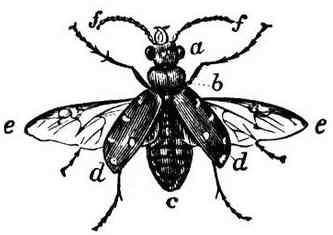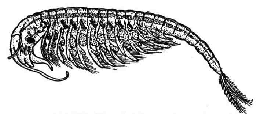BACKGROUND:
Arthropods are bilaterally symmetrical and
have jointed body segments with a pair of appendages attached to each body
segment. The body is covered with a cuticle (thickened substance) which comes
off ("molts") when the arthropod gets larger. There is no internal
skeleton. Their circulatory system is very simple and they reproduce by laying
eggs. Many insects go through metamorphosis or physical
changes. So a butterfly is the adult insect but the caterpillar is one
of the early stages and looks more like a "worm" than an insect. Many
arthropods like mosquitoes spend most of their life in an aquatic form before
it metamorphoses into a flying insect.
Identification of arthropods is not easy,
because there are so many "creepy crawlies" out there. Below is
information that may help you group arthropods for your students. You may want to
use other books or information on the internet to help identify the different arthropods.
Spiders, scorpions,
ticks, and horseshoe crabs belong to a group called the chelicerates. They
have no antennae and the first pair of appendages are pincher-like.
 The
arthropods called mandibulates
are characterized by their head appendages and include most of the
common arthropods.
We will be concentrating on the more common insect and crustacean groups.
A head (a), thorax (b), abdomen (c), wing cover or elytra (d), wing (e) and
antennae (f) are usually present. Crustaceans, such as brine shrimp, are predominantly aquatic and have gills
for respiration.
The
arthropods called mandibulates
are characterized by their head appendages and include most of the
common arthropods.
We will be concentrating on the more common insect and crustacean groups.
A head (a), thorax (b), abdomen (c), wing cover or elytra (d), wing (e) and
antennae (f) are usually present. Crustaceans, such as brine shrimp, are predominantly aquatic and have gills
for respiration.
PROCEDURE:
-
Read Ant Trails. It is a basic story about ant structure and
habits. At the end of the story there are some "Ant Facts."
Go over the basic parts which will help the students understand the rest of
the lesson. Ants belong to the Order
Hymenoptera.
-
Give students a
worksheet and bag of plastic insects. Instruct the students to try and find their
name (order level). On the worksheet students should describe the head, the body (thorax and
abdomen), and appendages (legs). You may want them draw the specimen on
the back of the sheet to help them look at the various parts. The important objective is to observe the different
types of arthropods. You may want to duplicate the sheet and have the
students make index cards of each of the group. You may want them to
use the cards to go outside and see if they can find other bugs in each
group. Remember it is not as important to classify them as it is to
thinking about grouping insects into groups.
Identification of adult land insects
on worksheet: Order Odonata Damselfly (right), dragonfly
(left); Order Orthoptera Grasshopper (right), Katydid
(left); Order Hemiptera Bug (right); Stink bug
(left); Order Homoptera Cicada (right); leafhopper (left);
Order Coleoptera firefly (right); ladybug (left); Order
Diptera fly (right); mosquito (left); Order
Lepidoptera butterfly (right); moth (left); Order
Hymertoptera bee (right); wasp (left).
-
Insects are some of the
most successful land organisms. Insects bite humans, irritate skin, and
sometimes cause disease. The insect body is composed of a head, thorax, and on
abdomen with 6 legs. The head has a pair of compound eyes.
-
 Brine shrimp are an effective way to look at arthropods. You can purchase
them at most pet stores. They are sometimes called "sea
monkeys." Brine shrimp are used to feed larger fish. We suggest
using a petri dish or other see through container and look at them with the
Swift GH microscope.
Brine shrimp are an effective way to look at arthropods. You can purchase
them at most pet stores. They are sometimes called "sea
monkeys." Brine shrimp are used to feed larger fish. We suggest
using a petri dish or other see through container and look at them with the
Swift GH microscope.
Brine shrimp belong to the
genus Artemia and are one of many small crustaceans of the order Anostraca
(class Branchiopoda) inhabiting brine pools and other highly saline inland
waters throughout the world. Young brine shrimp hatched there from dried eggs
are used widely as food for fish and other small animals in aquariums.
Measuring up to 15 mm (0.6 inch) in length, the body of the brine shrimp has a
discrete head with a large eye and stalked compound eyes, a thorax bearing a
series of limbs, and a slender abdomen without appendages. Brine shrimp
normally swim in an upside down position by rhythmically beating their legs.
They feed primarily on green algae, which they filter from the water with
their legs.
-
-
If you have trouble finding brine shrimp you can usually find
amphipods in pond water. They are small
aquatic "shrimp like" organisms that are abundant in pond water. You
can actually culture them in a fish tank using pond water.
-
As the students are looking under the
microscope make sure you direct their observations by comparing, contrasting,
and counting all segments.